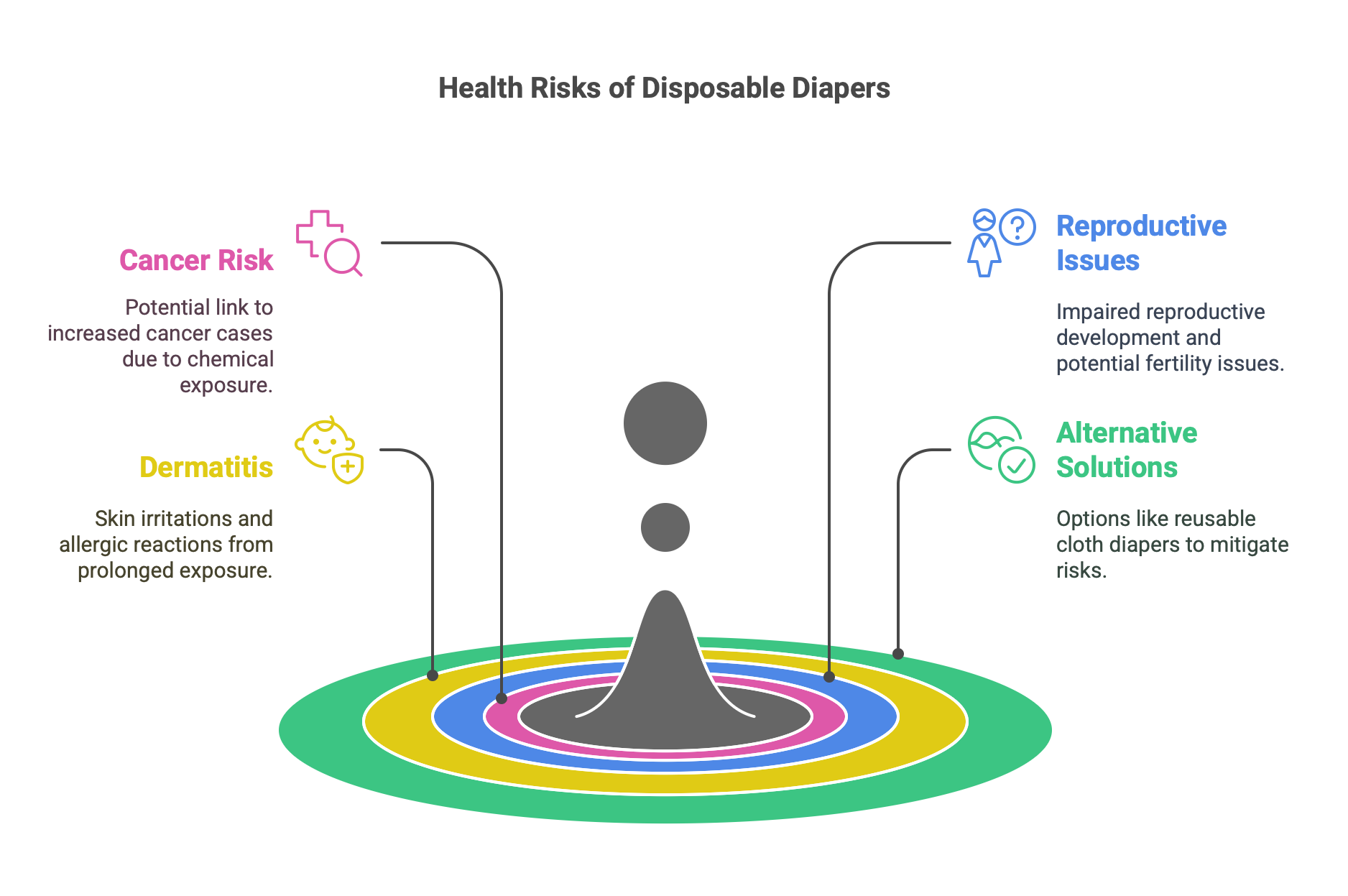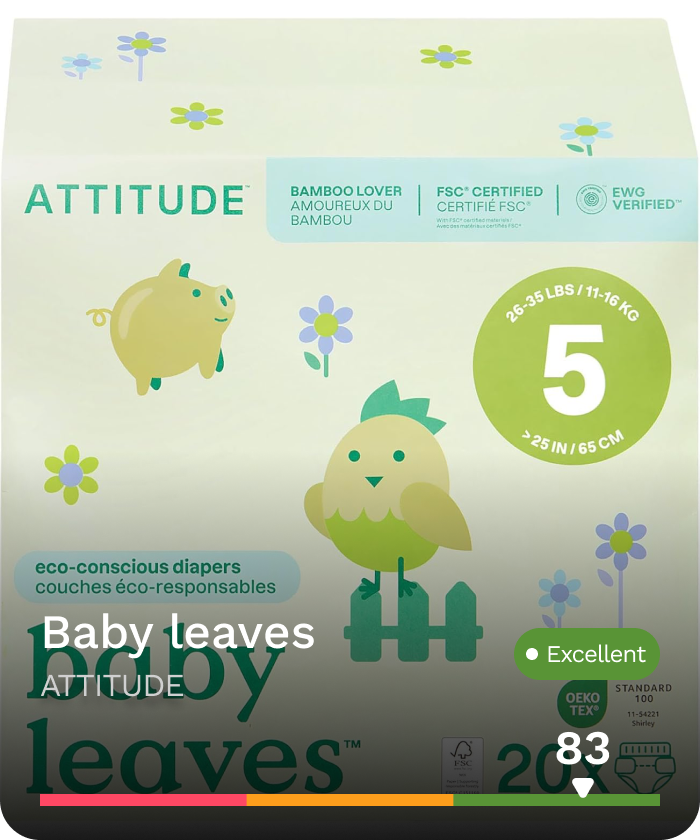TL;DR
Health Risks of Disposable Diapers
Disposable diapers, while convenient, may expose infants to over 60 hazardous chemicals, including dioxins and formaldehyde, which are linked to cancer, impaired reproductive development, and dermatitis. A 2019 study highlights prolonged exposure risks as diapers stay in contact with sensitive skin for extended periods.
-
Regulatory Gaps:
- The Consumer Product Safety Commission (CPSC) mandates only lead testing for diapers and does not require manufacturers to disclose ingredients.
- Comprehensive testing for other harmful chemicals is not enforced.
-
Safer Alternatives:
- Use reusable cloth diapers or brands that are free from dyes and fragrances.
- Awareness of diaper content can significantly reduce chemical exposure risks to infants.
Chemicals in Baby Diapers and Wipes
Hazards in Baby Wipes:
- Baby wipes often contain chemicals like parabens, phthalates, formaldehyde, triclosan, and phenoxyethanol, which pose risks like hormone disruption, skin irritation, respiratory issues, and developmental problems.
- Surfactants (SLS, SLES) and preservatives (MIT, IPBC, bronopol) can cause skin irritation and allergic reactions.
- Even “natural” or “sensitive” wipes may include hidden harmful chemicals due to lax ingredient disclosure regulations.
Hazards in Disposable Diapers:
- Over 60 harmful chemicals, including dioxins, formaldehyde, and pesticides, have been found in disposable diapers, linked to cancer, reproductive issues, and dermatitis.
- Fragrance chemicals like phthalates add to the risks, disrupting hormonal balance in infants.
Safety Gaps:
- Manufacturers are not required to disclose all ingredients, leaving consumers unaware of potential dangers.
- Testing for many harmful chemicals is not mandatory.
Recommendations for Parents:
- Opt for fragrance-free, dye-free, and chemical-free products.
- Choose organic or natural alternatives for both wipes and diapers to reduce exposure to hazardous substances.
Key Chemicals and Their Impacts
- PFAS (“Forever Chemicals”): Linked to hormonal disruptions, immune system issues, and developmental concerns in children due to their persistence in the body.
- Organophosphate Flame Retardants: Associated with nerve damage and increased risks of autism and multiple sclerosis.
- Quaternary Ammonium Compounds: Can harm brain nerves and pose developmental risks.
- Low pH Ingredients in Wipes: May cause skin irritation and other serious health concerns.
Advice for Parents
- Opt for PFAS-free products and those labeled as free from harmful additives.
- Prioritize products with clear ingredient labeling and avoid those with known harmful chemicals.
- Consider natural, organic, or cloth alternatives to reduce chemical exposure.
Long-Term Health Risk
Key Concerns for Baby Diapers:
- Over 60 hazardous chemicals identified in disposable diapers, including dioxins and formaldehyde, pose risks to reproductive and behavioral development.
- Prolonged exposure affects sensitive infant skin and may lead to long-lasting health issues.
Risks in Baby Wipes:
- Consumer Reports found 7 out of 15 brands containing concerning or unclear ingredients.
- Harmful chemicals linked to cancer risks and other health concerns are often present in wipes used on sensitive skin.
Steps to Minimize Exposure
- Read Labels Carefully: Avoid products with harmful chemicals like parabens, phthalates, formaldehyde, and triclosan.
- Choose Organic/ Natural: Opt for organic or natural baby wipes to avoid additional harmful chemicals.
- Be Informed: Research products and consult reliable sources like Consumer Reports to identify safe brands.
- Safety Certifications: Look for third-party safety certifications rather than relying on vague claims like “non-toxic” or “safe.”
- Reusable Alternatives: Consider using reusable cloth diapers and washable cloth wipes to reduce chemical exposure and environmental impact.
Introduction
Disposable diapers are a ubiquitous part of modern childcare, yet they pose signifi-
cant health risks due to the presence of hazardous chemicals. A 2019 study identified
over 60 potentially harmful chemicals in disposable diapers, including dioxins and
formaldehyde, which may affect reproductive and behavioral development[1]. These
diapers are in constant contact with a baby’s sensitive skin, often for extended
periods, exacerbating potential exposure to these dangerous substances[1].
Moreover, scientific assessments have linked certain chemicals in disposable dia-
pers to serious health issues such as cancer, impaired reproductive development,
and dermatitis[2]. Despite these risks, the Consumer Product Safety Commission
(CPSC), which regulates the diaper industry, does not mandate comprehensive
testing for a variety of chemicals in diaper products[2]. Additionally, diaper manu-
facturers are not required to disclose the ingredients used in their products, making
it challenging for consumers to identify safer options[2]. Currently, the CPSC only
requires that baby diapers be tested for lead[2].
Given the vulnerabilities of infants, who are particularly susceptible to the adverse
effects of chemical exposure, parents are advised to consider alternatives such as
reusable cloth diapers or choosing diapers that are free from dyes and fragrances[1].
Making informed decisions by being aware of the chemicals in baby products can
help in reducing these health risks.
ALVA Favourites
When you make a purchase through retailer links on our site, we may earn commission through affiliate programs. All affiliate fees ALVA receives support our mission. Learn more here
Are your products safe?
Scan your products now with the ALVA app to get a personalised risk analysis.

Concerning Chemicals in Baby Diapers and Wipes
Chemicals Found in Baby Diapers and Wipes
Baby wipes and disposable diapers, indispensable items in infant care, often contain
a variety of chemicals that can pose significant health risks to infants. Many popular
brands, such as Huggies and Pampers, use numerous chemicals to achieve the
desired scent, durability, and cleaning efficiency in their products[6].
Consumer Reports has highlighted that seven out of 15 brands of baby wipes tested
contain concerning or unclear ingredients, some of which are linked to cancer risks
and environmental harm[7][8]. These products frequently include potentially harmful
chemicals, including those made from plastics that do not break down easily in the
environment. Brands like Coterie and Costco acknowledge using small amounts
of certain chemicals as preservatives or skin conditioning agents, while Pampers
asserts that their ingredients undergo rigorous safety testing[7].
A comprehensive examination of baby wipes reveals that even products marketed
as “sensitive” or “all-natural” may still contain harmful ingredients. One of the most
common and problematic components is fragrance, often listed as “parfum” or “per-
fume”[11]. These fragrance mixes typically contain phthalates, which are chemicals
found in a range of consumer products, including personal care items, toys, and baby
medicines[11]. Phthalates are concerning because they can affect the endocrine
system, potentially disrupting hormonal balances and development in infants.
Moreover, the lack of transparency from manufacturers about the complete list of
ingredients in their products compounds the problem. Diaper and wipe manufacturers
are not legally required to disclose all materials used, leaving consumers uncertain
about what they are exposing their babies to[10]. As a result, parents and caregivers
must be diligent in researching and choosing products that minimize the risk of
harmful chemical exposure for their children.
Specific Harmful Chemicals and Their Health Effects
Disposable diapers and baby wipes are essential products for parents, but they often
contain chemicals that pose potential health risks to infants. Notably, common chem-
icals found in baby wipes include parabens, phthalates, formaldehyde, triclosan,
phenoxyethanol, ethylene oxide, 1,4-dioxane, sodium lauryl sulfate (SLS), sodium
laureth sulfate (SLES), methylisothiazolinone (MIT), iodopropynyl butylcarbamate
(IPBC), bronopol, and DMDM hydantoin[5].
Parabens, frequently used as preservatives, can disrupt hormone function by mim-
icking estrogen, potentially leading to developmental and reproductive issues[5].
Phthalates, another common ingredient often found in fragrance mixes, are linked to
respiratory problems, skin allergies, and even hormone disruption, which can affect
an infant’s reproductive development[4]. Formaldehyde, used for its preservative and
antibacterial properties, is a known carcinogen and can cause skin irritation and
allergic reactions[12].
Triclosan, an antibacterial agent, has been associated with hormone disruption
and the development of antibiotic-resistant bacteria[5]. Phenoxyethanol, used as a
preservative, can cause skin and lung irritation and has been linked to effects on
the brain and nervous system when absorbed through the skin[5]. Ethylene oxide,
used to sterilize medical equipment, is classified as a human carcinogen and may
be present in trace amounts due to contamination[5]. 1,4-Dioxane, a by-product of
the manufacturing process, is considered a probable human carcinogen and can be
absorbed through the skin[5].
Surfactants like sodium lauryl sulfate (SLS) and sodium laureth sulfate (SLES) can
strip the skin of its natural oils, causing irritation and allergic reactions[5]. Methylisoth-
iazolinone (MIT) and iodopropynyl butylcarbamate (IPBC) are preservatives that can
cause allergic contact dermatitis[5]. Bronopol and DMDM hydantoin are formalde-
hyde-releasing agents that can also lead to skin irritation and allergic reactions[5].
In addition to wipes, disposable diapers also contain hazardous chemicals. A 2019
study detected over 60 potentially hazardous chemicals in disposable diapers, includ-
ing dioxins and formaldehyde, which may have long-lasting effects on reproductive
and behavioral development[12]. The presence of pesticides and other chemicals
linked to cancer, impaired reproductive development, and dermatitis further raises
concerns about the safety of these products for infants[13].
Given these risks, parents are encouraged to choose products that are free from
fragrances, dyes, and harsh chemicals, and to consider using organic or natural
alternatives to minimize their babies’ exposure to these harmful substances[14][15].
Health Conditions and Developmental Issues
Prolonged exposure to hazardous chemicals found in baby diapers and wipes can
lead to a range of health conditions and developmental issues. One of the most
concerning groups of chemicals are PFAS (per- and polyfluoroalkyl substances),
often referred to as “forever chemicals” due to their persistence in the environment
and the human body. PFAS have been linked to hormonal disruptions, immune
system issues, and developmental concerns in children[16][20][22].
Furthermore, chemicals like organophosphate flame retardants and quaternary am-
monium compounds, commonly found in baby wipes, have been associated with
damaging brain nerves and increasing the risk of autism and multiple sclerosis[17].
Consumer Reports has highlighted that some baby wipes contain potentially harmful
ingredients, including those that may lead to cancer risks, skin irritation due to low
pH balance, and other serious health concerns[18][21].
Regulations and Standards
Regulations and standards surrounding the use of chemicals in baby diapers and
wipes vary significantly across different regions and are often deemed insufficient
to ensure the safety of infants. In the United States, the Consumer Product Safety
Commission (CPSC) is the primary regulatory body overseeing the diaper industry.
However, current regulations do not mandate that manufacturers test their products
for a broad range of harmful chemicals, nor do they require the disclosure of all ingre-
dients used in diapers. The CPSC does mandate testing for lead, but other chemicals,
including those linked to cancer and reproductive issues, are not comprehensively
regulated[25].
In the European Union, regulatory measures have also faced criticism for their inade-
quacy. The European Chemicals Agency’s (ECHA) Committee for Risk Assessment
concluded that there is insufficient scientific evidence to support the restriction of
certain harmful chemicals, such as formaldehyde, PAHs, dioxins, furans, and PCBs,
found in single-use diapers[24]. This decision highlights the ongoing debate about
the safety standards for baby diapers within the EU.
Recent studies have underscored the presence of hazardous chemicals in dispos-
able diapers, including over 60 potentially harmful substances such as dioxins and
formaldehyde. These chemicals can have long-lasting effects on the reproductive
and behavioral development of infants[26]. Despite these findings, both U.S. and
European regulatory frameworks have been criticized for their failure to fully protect
infants from these risks.
In response to these regulatory gaps, some organizations, like the Environmental
Working Group (EWG), have stepped in to provide additional guidance for parents.
The EWG has introduced its “EWG VERIFIED® Baby Diapers” mark to help con-
sumers identify safer diaper options free from chemicals of concern[23]. This initiative
aims to fill the void left by inadequate governmental regulations, offering parents a
more reliable way to choose safer products for their children.
Long-Term Health Effects
Long-Term Health Effects of Chemicals in Baby Diapers
Prolonged exposure to the concerning chemicals found in baby diapers and wipes
can pose significant long-term health risks to infants as they grow older. A 2019
study identified over 60 potentially hazardous chemicals in disposable diapers,
including dioxins and formaldehyde[28]. These chemicals are in constant contact with
a baby’s sensitive skin, often for extended periods. The potential long-lasting effects
on reproductive and behavioral development are particularly alarming[28]. Babies
are uniquely vulnerable to environmental chemicals, and reducing their exposure
can contribute to healthier growth and development[28]. Making informed decisions,
such as choosing reusable cloth diapers or those free from dyes and fragrances, can
mitigate these risks[29].
Health Risks of Chemicals in Baby Wipes for Infants
Prolonged exposure to certain chemicals found in baby wipes has been a cause for
concern among health experts and parents alike. Consumer Reports, in collaboration
with the independent organization Made Safe, conducted an investigation into the
ingredients used in baby wipes and found alarming results. Out of the 15 brands they
examined, seven contained ingredients deemed concerning or unclear[30].
These wipes were found to contain potentially harmful chemicals, including sub-
stances that may be linked to cancer risks[30]. The presence of such chemicals in
products frequently used on infants’ sensitive skin raises significant health concerns.
While the immediate effects might not be visible, the potential long-term health
effects of these chemicals can be severe. Infants exposed to these chemicals over
a prolonged period might face increased risks of developing health issues as they
grow older[30].
Ensuring the safety of baby wipes is crucial, given their widespread use. Parents
and caregivers are urged to scrutinize the ingredient lists of baby wipes and opt
for products that have been certified free from harmful chemicals to mitigate these
risks[30].
Steps to Minimize Exposure
Parents can take several steps to minimize their baby’s exposure to potentially
harmful chemicals in diapers and wipes. First, they should carefully read labels and
avoid products with ingredients known to be harmful, such as parabens, phthalates,
formaldehyde, and triclosan[31][36]. Opting for organic or natural baby wipes, which
typically do not contain these additional chemicals, is also a safer choice[31].
It’s important to note that many diaper and wipe manufacturers are not required to
disclose all the ingredients used in their products[32]. This lack of transparency can
make it difficult for parents to make informed choices. However, conducting some
research and consulting reliable sources can help. Organizations like Consumer
Reports have investigated various brands and identified those with concerning or
unclear ingredients[33][35].
Additionally, choosing products from companies that undergo rigorous safety testing
can reduce the risk of exposure to harmful chemicals[33]. Parents should be wary of
marketing claims that emphasize “non-toxic” or “safe” without clear evidence to back
these claims[31]. Instead, looking for certifications from independent organizations
can provide more reliable assurance of safety.
Lastly, considering alternatives like reusable cloth diapers and washable cloth wipes
can significantly reduce chemical exposure and are better for the environment[31].
While it’s nearly impossible to avoid all chemicals entirely, being vigilant about the
products used and making informed choices can significantly minimize the risks to a
baby’s health[36][37].
REFERENCES:
[1]: Do Diapers Have Chemicals That Are Dangerous to Baby Health? (2025)
[2]: EWG’s Healthy Living: Guide to Safer Diapers
[3]: Are Baby Wipes Toxic? Chemicals and Ingredients List – MomInformed
[4]: Ingredients in Baby Wipes: Common Chemicals and Sulfates – The Good Nursery
[5]: 10 Common Chemicals in Baby Wipes You Might Want To Avoid!
[6]: Are Baby Wipes Toxic? Chemicals and Ingredients List – MomInformed
[7]: Consumer Reports finds unclear ingredients in seven brands of baby wipes
[8]: Investigating ingredients found in popular brands of baby wipes and …
[9]: Toxic Chemicals in Disposable Diapers (+ How to Avoid Them)
[10]: Non-Toxic Baby Care: Disposable Diaper and Baby Wipes … – MAMAVATION
[11]: Ingredients in Baby Wipes: Common Chemicals and Sulfates – The Good Nursery
[12]: Do Diapers Have Chemicals That Are Dangerous to Baby Health? (2025)
[13]: EWG’s Healthy Living: Guide to Safer Diapers
[14]: Are Baby Wipes Toxic? Chemicals and Ingredients List – MomInformed
[15]: Non-Toxic Baby Care: Disposable Diaper and Baby Wipes … – MAMAVATION
[16]: What Is PFAS in Baby Wipes Dangerous? Understanding Risks and Safer …
[17]: Chemicals found in baby wipes, hand soaps may raise risk of … – News9Live
[18]: Consumer Reports finds unclear ingredients in seven brands of baby wipes
[19]: What Are PFAS in Baby Wipes and Why You Should Avoid Them for Your …
[20]: What Are PFAS in Baby Wipes Safe: Understanding Risks and Choosing …
[21]: Hidden Chemicals in Baby Wipes: What Parents Should Know
[22]: What Are PFAS and Why Are They Allegedly in Baby Wipes? – Green Matters
[23]: EWG VERIFIED® Baby Diapers: Filling the gap when regulators fail to …
[25]: EWG’s Healthy Living: Guide to Safer Diapers
[26]: Do Diapers Have Chemicals That Are Dangerous to Baby Health? (2025)
[27]: EWG Releases New Guide to Safe Disposable Diapers – Treehugger
[28]: Do Diapers Have Chemicals That Are Dangerous to Baby Health? (2025)
[29]: Toxic Chemicals in Disposable Diapers (+ How to Avoid Them)
[30]: What’s in baby wipes? Consumer Reports finds ‘concerning’ ingredients …
[31]: Are Baby Wipes Toxic? Chemicals and Ingredients List – MomInformed
[32]: Non-Toxic Baby Care: Disposable Diaper and Baby Wipes … – MAMAVATION
[33]: Consumer Reports finds unclear ingredients in seven brands of baby wipes
[34]: Toxic Chemicals in Disposable Diapers (+ How to Avoid Them)
[35]: Investigating ingredients found in popular brands of baby wipes and …
[36]: 10 Common Chemicals in Baby Wipes You Might Want To Avoid!
[37]: What’s In Baby Wipes? (Sneaky Ingredients of Baby Wipes to Look Out For …
Are your products save?
Download ALVA to check if the products you use regularly are free from dangerous chemicals.

